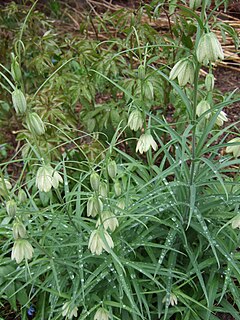
Fritillaria (fritillaries) is a genus of spring flowering herbaceous bulbous perennial plants in the lily family (Liliaceae). The type species, Fritillaria meleagris, was first described in Europe in 1571, while other species from the Middle East and Asia were also introduced to Europe at that time. The genus has about 130–140 species divided among eight subgenera. The flowers are usually solitary, nodding and bell-shaped with bulbs that have fleshy scales, resembling those of lilies. They are known for their large genome size and genetically are very closely related to lilies. They are native to the temperate regions of the Northern hemisphere, from the Mediterranean and North Africa through Eurasia and southwest Asia to western North America. Many are endangered due to enthusiastic picking.

Fritillaria verticillata is a flowering plant in the lily family Liliaceae, native to Japan, Korea, Mongolia, Xinjiang, Kazakhstan and the Altay region of Siberia.

Fritillaria pallidiflora is an Asian species of bulbous flowering plant in the lily family Liliaceae, native to Xinjiang, Kyrgyzstan and Kazakhstan. The common name frequently used is Siberian fritillary, a misnomer because the species does not grow in the wild in Siberia.

Fritillaria ojaiensis is a rare species of fritillary known by the common name Ojai fritillary.
Fritillaria anhuiensis is a Chinese species of bulb-forming flowering plant in the lily family Liliaceae. It is native to Anhui and Henan Provinces in China.
Fritillaria cirrhosa, common name yellow Himalayan fritillary, is an Asian species of herbaceous plant in the lily family, native to China, the Indian Subcontinent, and Myanmar.
Fritillaria maximowiczii is a plant species known from northeastern China and eastern Russia.
Fritillaria yuzhongensis is a plant species native to China. It grows on open grassy hillsides at elevations of 1,800–3,500 m (5,900–11,500 ft).
Fritillaria crassicaulis is an Asian species of herbaceous plant in the lily family Liliaceae, native to Sichuan and Yunnan Provinces in China.
Fritillaria unibracteata is a species of flowering plant in the lily family Liliaceae, native to Gansu, Qinghai, Sichuan Provinces in China.
Fritillaria dajinensis is an Asian species of herbaceous plant in the lily family, native to Sichuan Province in China.
Fritillaria monantha is a Chinese plant species in the lily family Liliaceae. It is found only in China, in the Provinces of Anhui, Henan, Hubei, Jiangxi, Sichuan, and Zhejiang.
Fritillaria przewalskii is a Chinese flowering plant species in the lily family Liliaceae. It is found only in China, in the Provinces of Gansu, Qinghai and Sichuan.

Fritillaria sinica is a Chinese flowering plant species in the lily family Liliaceae. It is found in the wild only in the Province of Sichuan in southwestern China, although it is sometimes cultivated as an ornamental in other regions.
Fritillaria taipaiensis is a flowering plant species in the lily family Liliaceae. It is found only in China, in the Provinces of Gansu, Hubei, Shaanxi and Sichuan.

Fritillaria thunbergii is a flowering plant species in the lily family Liliaceae. It is native to Kazakhstan and in Xinjiang Province of western China, though cultivated in other places and naturalized in Japan and in other parts of China.
Fritillaria tortifolia is a flowering plant species in the lily family Liliaceae. It is found only in the northwestern part of Xinjiang Province, the extreme northwestern corner of China.
Fritillaria yuminensis is a plant species native to the northwestern part of Xinjiang Province in northwestern China. It grows in open grassy hillsides at elevations of 1,000–3,500 m (3,300–11,500 ft).
Zanthoxylum austrosinense, or South Chinese Sichuan pepper, is a woody plant in the family Rutaceae and is native to southern China.





